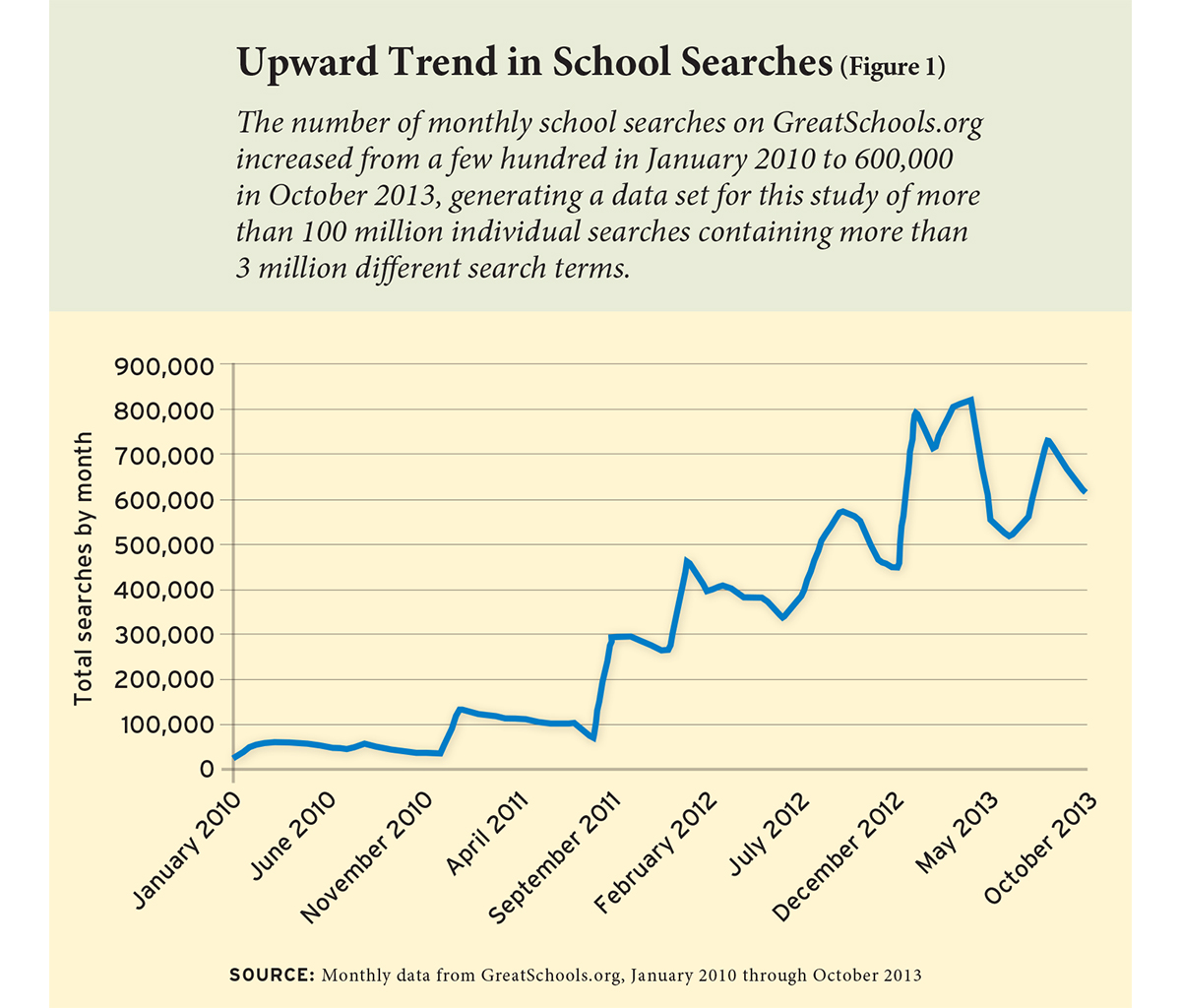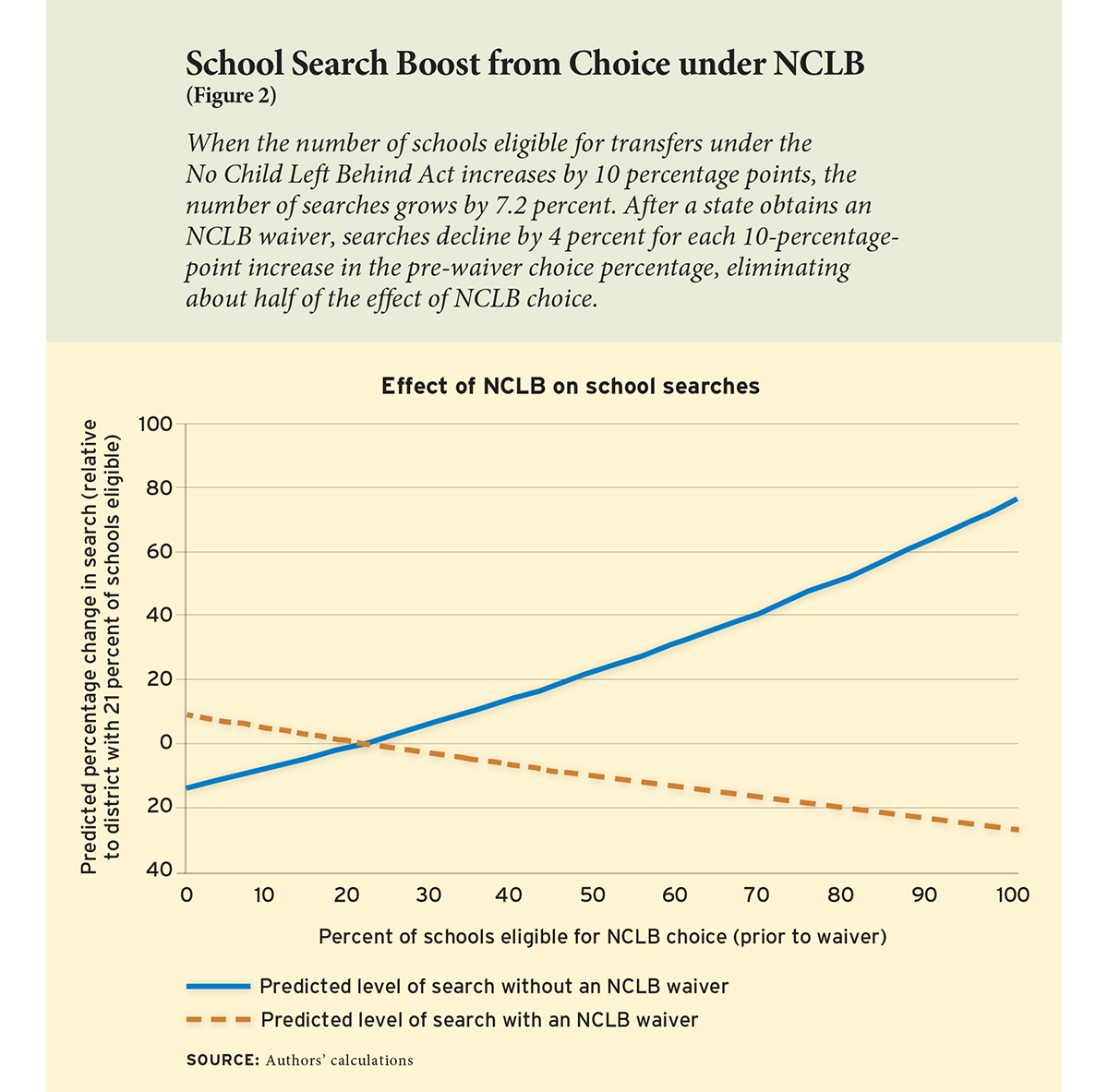
Policies that expand school choice aim to empower parents by giving them the opportunity to choose the school that best fits their child. Publicly funded school choice has increased considerably in recent years, helped by a variety of initiatives, including public charter schools, transfer options for students under the No Child Left Behind Act (NCLB), inter-district enrollment programs, and a variety of policies to subsidize private-school tuition.
School choice has the potential to promote equity by allowing students to attend schools outside their neighborhood zone. But school choice can only fulfill this potential if parents are informed about their options. Information about school quality has proliferated in the past decade, thanks to federal accountability rules and the widespread accessibility of school performance data via the Internet. Yet despite the increase in the supply of information, critics allege that many parents still don’t know enough about local schools to take full advantage of school choice.
This raises a question that has not been addressed: if choice programs rely on knowledgeable parents to drive competition and market-based decisions, do such programs act as an incentive for parents to become more informed? Does the existence of a choice program cause parents to seek information about their educational options? If this is the case, then concerns based on how informed parents are in areas where choice is limited may not tell us much about how informed they would be if given more options.
We address this question by analyzing more than 100 million individual searches on the nation’s largest school-quality website, GreatSchools.org. These data are linked to information on changes both in public school-choice options under the now-defunct NCLB law and in the number of charter schools in an area. Our analysis constitutes the first direct assessment of how the demand for school-quality information responds to the choice environment.
We find consistent evidence that search frequency increases due to the expansion of school choice as a result of NCLB and the growth of charter schools. This finding suggests that the mere availability of school information is not sufficient to alleviate knowledge gaps; rather, parents must also have an incentive to seek out and use the information available. Given prior findings that clear information about school quality can lead parents to choose schools that increase student achievement, our study highlights the potential value of pairing choice policies with easily accessible data on school quality.
Data
The key challenge facing empirical study of how school choice affects information acquisition has been a lack of systematic data. We fill this gap with online search behavior from GreatSchools, a nonprofit organization that provides comparison information and, in some cases, user reviews on all K–12 schools in the United States. The GreatSchools website supplies users with simple and straightforward information on school test scores and demographics in a manner that enables comparisons across schools. It is free and does not require registration.
Specifically, the website provides up-to-date information on school enrollment, grade levels served, the racial and ethnic makeup of the student body, and performance on standardized tests. Featured prominently are two pieces of information that may be of particular interest to families with children: a score of 1-10 based on recent standardized test results, and “community ratings” that ostensibly come from current and former students and their families. Schools are rated 1-5 stars on three factors: teacher quality, principal leadership, and parent involvement. There are direct testimonials from reviewers as well.
Our data come from the universe of specific search terms entered by users from January 1, 2010, through October 31, 2013. The data contain specific text strings entered into the search bar and the number of times each term was searched each month. Users had the option of entering the name of a city (e.g., Rochester), a school district (e.g., Brighton), a school (e.g., Twelve Corners Middle School), or a Zip Code (e.g., 14810). Users also could enter addresses and find schools near those addresses, and starting in August 2011, they could specify a particular state from a new drop-down menu. Our data do not reveal the origin of the search (such as a user’s IP address).
The data comprise 102,616,862 individual searches that contain more than three million different search terms over the almost four-year study period, with the number of searches increasing rapidly each year (see Figure 1). Using these raw search data, we generate counts of searches for each month for all geographic areas that potentially constitute a school-choice zone for residents. We identify 1,854 of these “search units,” which are a mix of cities and counties. We can match about 80 percent of the total searches to search units that form the basis for our analysis. Unmatched searches include those with typos and those for school names that are too generic to be matched to a specific search unit.

The lack of state identifiers in the data prior to August 2011 creates some difficulties in matching searches to locations. Some city names, such as “Springfield” and “Portland,” exist in multiple states; the same is true for school district and county names. Our solution is to assign these searches to search units in the same proportions pre-August 2011 as we observe after August 2011, when state identifiers became available.
We also collect data on public school-transfer options generated by NCLB, which required schools that received Title I funds and failed to meet minimum requirements on standardized tests for two consecutive years to offer students the option of transferring to a local school that did meet the benchmark. This information is available for 39 states; the remaining states did not publish information about school-improvement outcomes under NCLB during our study period. On average during our study period, about 21 percent of schools in the 39 states with this information had NCLB-induced choice, with considerable variation across areas and over time.
Finally, we also gather data on the number of charter schools in each search unit as an additional measure of school choice. On average, each search unit had 5.4 charter schools in it over the course of our study period, again with ample variation. Over 41 percent of the 1,854 search units had at least one charter school, while 25 percent had more than two, and 10 percent had 12 or more.
Method
Our goal is to measure the causal impact of school-choice policies on demand for information about school quality as indicated by the number of searches on GreatSchools. Simply examining the association between choice policies and school searches would be misleading, because areas that have more school choice may have more search behavior for any number of reasons, including perhaps that their residents had higher demand for choice options in the first place.
We instead focus on changes over time within each search unit. For example, does search behavior increase by a larger amount in areas where more schools became eligible for NCLB choice? This approach allows us to account for any differences across cities that remain during the four-year period we study.
Our analysis also takes into account the month and year in which each search was conducted. Both the prevalence of school choice and the overall number of searches were generally increasing during the roughly four-year period we study, but the increase in traffic could simply reflect increasing familiarity with the GreatSchools website as a resource. By adjusting the numbers of searches in a given area for the number of searches nationwide, we can be more confident that any changes we observe in that area are driven by changes in the choice environment.
Results
We find clear evidence that the availability of public school-choice options under NCLB increased demand for information on school quality. As the number of low-performing schools eligible for transfer options grew under NCLB, the number of Internet searches about those search units increased. Similarly, when states received waivers from NCLB that permitted them to stop providing transfer options for new students, the number of searches fell.
When the number of schools eligible for transfers under NCLB increases by 10 percentage points, the number of searches climbs by 7.2 percent (see Figure 2). An increase of one standard deviation in NCLB choice of 21 percentage points thus would imply a 15.1 percent increase in search frequency.

The availability of choice under NCLB largely vanished when the Department of Education began granting waivers of many of the law’s requirements to states. Between 2010 and 2013, 34 of the 39 states in our analysis received such a waiver. States that were granted a waiver usually allowed students who had already switched schools to continue their enrollment, but they eliminated school-choice options for other students in Title I schools previously identified as being in need of school improvement and for students in newly identified schools.
We would expect any effects of such waivers on the demand for school-quality information to be proportional to the percentage of the population that previously had access to NCLB-based choice. Indeed, we find that the effect of choice options under NCLB becomes weaker after a state obtains an NCLB waiver, with searches declining by 4 percent for each 10-percentage-point increase in the pre-waiver choice percentage. Thus, waivers reduce the effect of NCLB choice by more than half.
To put the size of these estimates into perspective, it is helpful to compare them to the proportion of families moving into the search area in a given year. These families are more likely to engage in online school research and to use GreatSchools.org in the absence of school choice. Comparing changes in search rates to mobility rates also provides a lower bound on the amount of online searching done by existing residents because of choice.
Using the 2010-14 American Community Survey, we calculate the proportion of families with a 5- to 17-year-old child in each search unit that did not live in the area the prior year. On average, about 5 percent of search-unit families are new entrants each year. Thus, even under the extreme assumption that all families entering an area would use the GreatSchools website, our estimates suggest resident families, spurred by the availability of NCLB-based choice, are responsible for a large share of online searches.
We also assess how school-search frequency changes based on the number of available charter schools in the search unit. Our findings indicate that adding a charter school to an area is associated with a 5.3 percent increase in searches. We caution that the opening of new charter schools could reflect an increase in demand for choice, and that this part of our analysis is not based on sudden changes in school ratings (as in the case of NCLB-based choice) or a policy change (as in the case of NCLB waivers). But this result provides suggestive evidence that charter school entry induces parents to obtain school-quality information and that the effect of choice on demand for information may not be limited to NCLB.
Implications
Our results indicate that parents respond to increased school-choice options by collecting more information about the quality of local schools. This novel finding has several important implications.
First, it implies that for many families, the availability of school-quality information alone is not sufficient to lead them to become better informed about school options. Parents must also have an incentive to seek and use this information. It is perhaps not surprising that families with few school-choice options are less likely to access the available information about schools in the area. This finding can help explain why, even in the information-rich post-NCLB world, some parents appear to have incomplete information about schools.
Second, our findings point to an additional channel through which school-choice policies affect parental behavior. In addition to increasing families’ choice sets, these policies can induce parents to seek information about school quality. To the extent that better information improves the match between families and schools or leads to pressure on schools to increase measured achievement, this effect can augment the impacts of school-choice policies.
Third, our results suggest that online search tools such as GreatSchools can be powerful mechanisms through which to provide families with the information they need to take advantage of choice programs and about local schooling options more broadly. That the information is being provided by an independent third party might increase the credibility of the information from parents’ perspectives, although more research is needed to understand how parents interpret school-quality information from different sources.
Michael F. Lovenheim is an associate professor in the Department of Policy Analysis and Management at Cornell University. Patrick Walsh is an associate professor of economics at St. Michael’s College.
This article appeared in the Winter 2018 issue of Education Next. Suggested citation format:
Lovenheim, M.F., and Walsh, P. (2018). (Re)Searching for a School: How choice drives parents to become more informed. Education Next, 18(1), 72-77.


